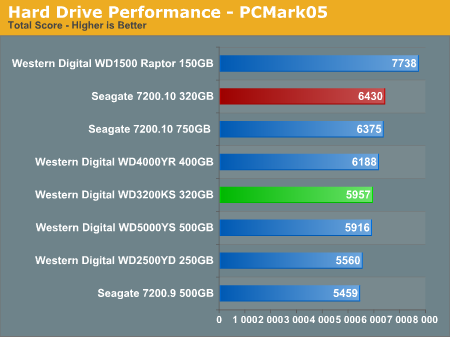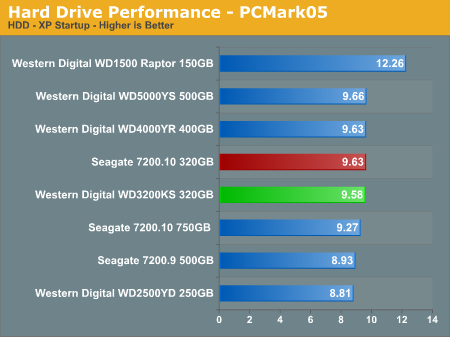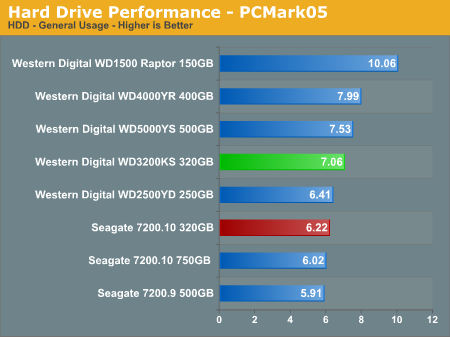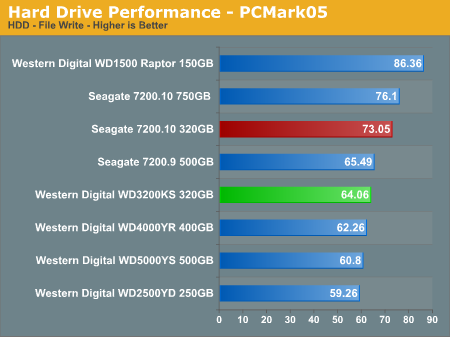Western Digital and Seagate: 320GB Grudge Match
by Gary Key on July 27, 2006 2:00 AM EST- Posted in
- Storage
Hard Disk Performance: PCMark05
We are utilizing the HDD test suite within PCMark05 for further comparative hard disk scores as it provides a mixture of actual application results and specific read/write percentages utilized within these programs. It also allows interested readers to generate comparative results. The program utilizes the RankDisk application within the Intel IPEAK SPT suite of tools to record a trace of disk activity during usage of real world applications. These traces are then replayed to generate performance measurements based upon the actual disk operations within each application. The HDD test suite contains 53% read and 47% write operations with each trace section utilizing varied amounts of read or write operations. Additional information about the test suite can be found in PDF format here PCMark05 whitepaper.
Our test results are based upon the following trace runs:
Windows XP Startup: This test consists of 90% reading and 10% writes that tracks XP activities at start-up.
Application Loading: This test consists of 83% reading and 17% writes that tracks the opening and closing of the following programs.
General Hard Disk Drive Usage: This test consists of 60% reading and 40% writes that tracks application usage utilizing the following settings.
Virus Scanning: This test consists of 99.5% read operations as the test tracks the scanning activities of 600MB of files for viruses.
File Write: This test consists of 100% write activities by writing 680MB of files onto the hard disk.






Our PCMark05 numbers follow a familiar test pattern with the WD Raptor having a 20% advantage over the Seagate 320GB drive and 29% over the WD 320GB in the total score number. The performance delta between the two 320GB drives is 11% although this is primarily due to the Virus Scanning and File Write test results.
The general usage and application benchmarks that represent the majority of daily operations on a typical PC configuration favor the Western Digital drive. Both of the 320GB drives are very close throughout the first four tests and it is only when we get to the Virus Scanning and File Write tests that we see the Seagate drive hold a commanding lead. We believe the short file sizes and very sequential nature of the test file in the Virus and Write tests heavily favor the Seagate 320GB drive, though we are continuing our investigation.
We are utilizing the HDD test suite within PCMark05 for further comparative hard disk scores as it provides a mixture of actual application results and specific read/write percentages utilized within these programs. It also allows interested readers to generate comparative results. The program utilizes the RankDisk application within the Intel IPEAK SPT suite of tools to record a trace of disk activity during usage of real world applications. These traces are then replayed to generate performance measurements based upon the actual disk operations within each application. The HDD test suite contains 53% read and 47% write operations with each trace section utilizing varied amounts of read or write operations. Additional information about the test suite can be found in PDF format here PCMark05 whitepaper.
Our test results are based upon the following trace runs:
Windows XP Startup: This test consists of 90% reading and 10% writes that tracks XP activities at start-up.
Application Loading: This test consists of 83% reading and 17% writes that tracks the opening and closing of the following programs.
- Microsoft Word
- Adobe Acrobat Reader
- Windows Media Player
- 3Dmark 2001SE
- Leadtek Winfast DVD
- Mozilla Internet Browser
General Hard Disk Drive Usage: This test consists of 60% reading and 40% writes that tracks application usage utilizing the following settings.
- Opening a Microsoft Word document, performing grammar check, saving and closing.
- Compression and decompression using Winzip.
- Encrypting and decrypting a file using PowerCrypt.
- Scanning files for viruses using F-Secure Antivirus.
- Playing an MP3 file with Winamp.
- Playing a WAV file with Winamp.
- Playing a DivX video using DivX codec and Windows Media Player.
- Playing a WMV video file using Windows Media Player.
- Viewing pictures using Windows Picture Viewer.
- Browsing the Internet using Microsoft Internet Explorer.
- Loading, playing and exiting a game with Tom Clancy's Ghost Recon.
Virus Scanning: This test consists of 99.5% read operations as the test tracks the scanning activities of 600MB of files for viruses.
File Write: This test consists of 100% write activities by writing 680MB of files onto the hard disk.






Our PCMark05 numbers follow a familiar test pattern with the WD Raptor having a 20% advantage over the Seagate 320GB drive and 29% over the WD 320GB in the total score number. The performance delta between the two 320GB drives is 11% although this is primarily due to the Virus Scanning and File Write test results.
The general usage and application benchmarks that represent the majority of daily operations on a typical PC configuration favor the Western Digital drive. Both of the 320GB drives are very close throughout the first four tests and it is only when we get to the Virus Scanning and File Write tests that we see the Seagate drive hold a commanding lead. We believe the short file sizes and very sequential nature of the test file in the Virus and Write tests heavily favor the Seagate 320GB drive, though we are continuing our investigation.










20 Comments
View All Comments
patentman - Monday, July 31, 2006 - link
To avoid superparamagnetism, engineers have been increasing the coercivity, the field size required to write a bit, of the disc media. These fields are limited by the magnetic materials making up the write head that will soon effectively limit drive sizes utilizing longitudinal recording. Although additional capacities are still achievable, the drive industry will be moving to perpendicular recording technology shortly as longitudinal recording has basically hit the proverbial brick wall after being utilized for nearly 50 years."I wrote a pretty detailed post on the anandtech forums about this a while back. You can check it out http://forums.anandtech.com/messageview.aspx?catid...">here" (I used to post under the nickname "klaviernista"). Considering I examined and issued a lot fo the patents that are the basis of seagate's perpendicular technology, I think I am more than qualified to speak on the matter.
Oh, and for the record, the "soft" magent under layer is never truly "written to" during the reocrind gprocess. The soft magnetic underlayer is made of a material that has magnetic domains which rotate easily in response to an external magentic field. When the write field goes across any given point in the medium, it induces the field in the corresponding point on the soft magentic underlayer to rotate perpendicular to the medium. The article is correct in saying that the result is a substantial increase in write field intensity, but neglects to mention that the fields of the soft magnetic underlayer to not remain oriented perpendicular to the media surface after the write field from the magentic head is removed, whereas the fields in the magentic recording layer do remain oriented perpendicular to the media surface.
The whole point of usuing a soft magnetic underlayer is to allow magnetic materials with very high coercivity to be used as the recoprding layer. Why do you need a very high coercivity recording layer in high density recordng media? See the post I linked to above and read the discussed about "intergranular exchange coupling."
jackylman - Thursday, July 27, 2006 - link
In the pulldown menu, accoustics -> acousticsSonicIce - Thursday, July 27, 2006 - link
Even with an extra platter to lug around, the Western Digital was quieter and cooler!madfly - Thursday, July 27, 2006 - link
if you want to have the seagate hard drive cross shipped where they send you a replacement and you return the defective one back to them they charge $25, considering the hard drive cost $99, that there is a ripoff. I had this happen to me with a 250GB HD that I bought last year, so I'll be spending my money with one of the others unless the deal is ridiculous.Mana211 - Thursday, July 27, 2006 - link
SPCR uses 1 meter (aka 1000mm or 200 times your stated distance) to measure SPL."Each drive is measured for SPL one meter away from the top of the hard drive. Hard drive noise tends to be directional, the loudest position being directly over the top. SPL readings typically drop by 2~3 dBA/1m when measured from the side of the drive. The drive is placed on a soft foam to ensure that no vibration noise is produced during testing."
The there is an entire category of sounds you hear at 5mm that wouldn't be noticable from outside a case.
Take this quote from SPCR: "Consider the distance of Hardware.fr's recording microphone: 5cm from the HDD. This is a serious problem. There's no way the decibel reading can be accurate due to boundary effects. It's the same problem at storagereview.com -- not even relative differences are necessarily correct due to compression effects; the close proximity impacts every measurement similarly, reducing differences."
http://www.silentpcreview.com/article631-page1.htm...">http://www.silentpcreview.com/article631-page1.htm... shows that the new audio recordings (not to be confused with the SPL Dba numbers) will use two recording distances:
* One meter so that "nominal" volume, audibility, and sound character can be judged.
* One foot (or 30 cm if you will) to capture all the details from even the quietest noise sources.
tuteja1986 - Thursday, July 27, 2006 - link
Western digital for me since i want a quiet and cool drive.crydee - Thursday, July 27, 2006 - link
The WD400YR and WD500YS seem very close to performance with the Raptor, but I can't find the WD400YR on pricewatch on newegg also I read about the WD drivers having a high rate of doa?AdamK47 3DS - Thursday, July 27, 2006 - link
The Seagate drive has a performance advantage with the two 160GB platters. Anandtech is still ignoring the advantages of higher platter densities. Why is that? Platter density is one of the features I look at when purchasing a new drive. It's a good indication of performance when compared to another drive of the same total capacity. You have two 320GB drives reviewed with different number of platters and yet there is no mention of this other than the table. It's very odd.evilharp - Thursday, July 27, 2006 - link
Check your "price bot" settings. Currently you list the following deals for a "Western Digital Caviar® SE16"I followed the Business Computing Network link (simply due to the crazy price) and it is for a 20 unit bulk purchase.
Booty - Thursday, July 27, 2006 - link
On the last page it should be listed that the WD has a 3 year warranty for retail and 1 year for OEM - you have them switched.